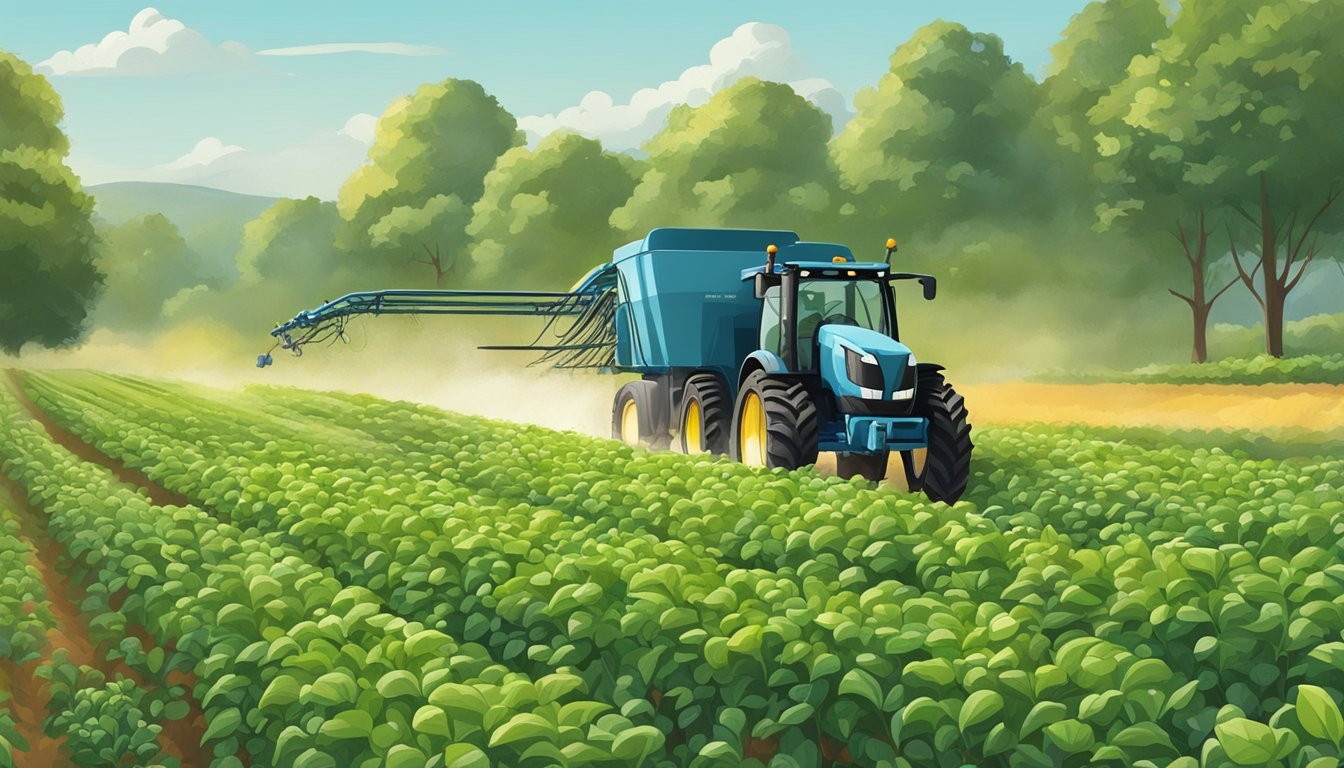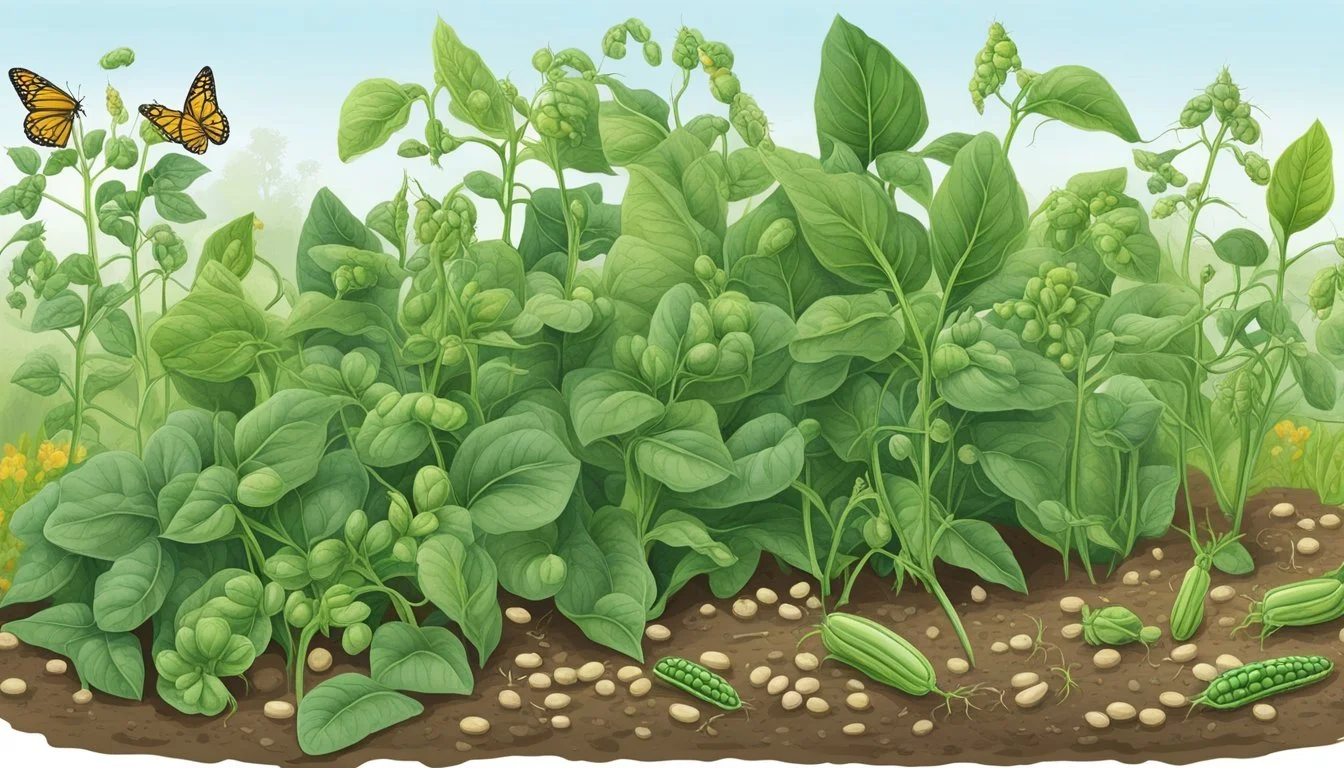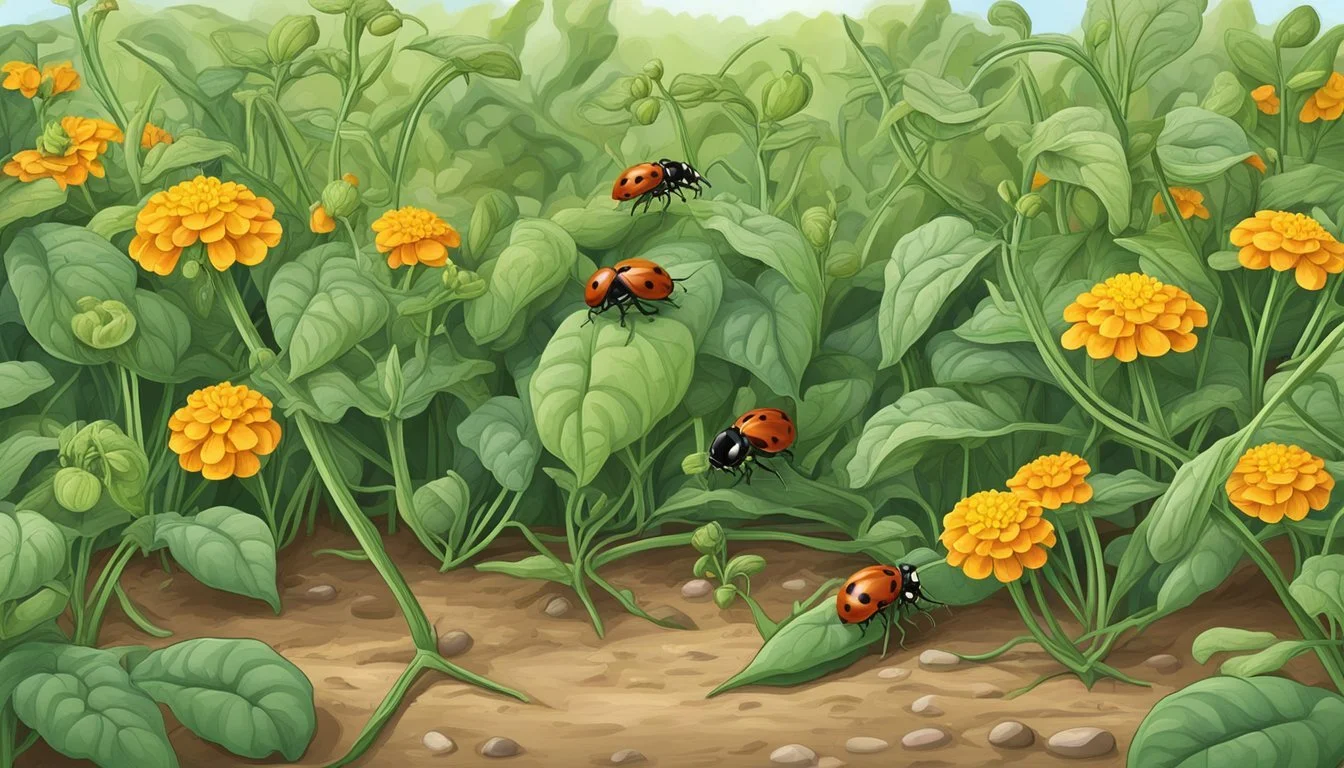Pest Control for Cowpeas
Effective Strategies for Protecting Black-Eyed Peas
Cowpeas, commonly known as black-eyed peas, are a staple crop in many parts of the globe, valued for their nutritional benefits and versatility in various cuisines. However, like any crop, they are susceptible to pest infestations, which can significantly reduce yield and quality. Managing these pest populations is crucial for farmers who rely on cowpeas as a food source or economic crop. Effective pest control strategies are necessary not only for the health of the plants but also for the sustainability of cowpea production.
The cowpea curculio, for example, is one of the most destructive pests of cowpeas. It can cause considerable damage to the pods, impacting both the quantity and quality of the harvest. Gardeners and large-scale growers alike must be vigilant and proactive in protecting their crops. This includes monitoring for pest activity, understanding the life cycle of key pests, and knowing both preventive measures and targeted interventions that can reduce or eliminate the threat from pests such as curculios.
Several methods can be employed in the fight against cowpea pests, ranging from cultural practices that discourage pest colonization to the use of resistant varieties. Implementing strategies such as proper crop rotation, sanitation, and the timely planting of cowpeas can greatly influence the prevalence of pests. Moreover, the selection of cowpea varieties with attributes such as thick pod walls can naturally reduce the damage caused by pests. With conscientious management and appropriate control tactics, the challenges posed by pests can be substantially mitigated, ensuring healthy and productive cowpea plants.
Understanding Cowpeas
Cowpeas, commonly referred to as black-eyed peas, are a versatile and important legume crop. This section provides insights into their botanical classification, preferred growing conditions, and the variety of cowpeas that can be cultivated.
Botanical Profile
Cowpeas (Vigna unguiculata) are a leguminous crop commonly appreciated for their distinctive black-eyed seeds. These plants are endowed with a pod color ranging from green to tan or brown when mature. Originating in Africa, cowpeas are not only a source of food but also play a role in soil fertility as they fix nitrogen.
Growth Habits
Typically, cowpeas thrive in warm climates and are often found in southern regions where they are also known as southern peas or field peas. They exhibit a growth habit that can vary from erect to semi-erect or trailing vines. The plants demonstrate resilience in arid conditions and tend to bloom with flowers that can be white, yellow, or purple in color.
Varieties of Cowpeas
Cowpeas come in several varieties, each with unique characteristics such as pod thickness and susceptibility to pests. Some varieties show resistance by having thick pod walls, which can be an asset in managing cowpea curculio pests. The seeds are typically tan, brown, or black with a prominent "eye" where they are attached to the pod.
By understanding these basics of cowpeas, gardeners and farmers can better plan their cultivation strategies to optimize growth and yield while managing pests effectively.
Cultivation Practices
Effective cultivation practices are pivotal to the successful growth of cowpeas. Such practices encompass specific soil conditions, precise planting techniques, appropriate watering and fertilization, and diligent weed management to foster robust cowpea plants.
Soil Requirements
Cowpeas thrive in well-drained soils with a pH between 5.5 and 6.5. The ideal soil for planting cowpeas should be loamy to sandy. Before planting, soil temperature should be closely monitored to ensure it is adequate for germination.
Planting Techniques
For optimal growth, cowpeas should be planted in rows, ensuring about 30 inches between each. The seeds require direct sunlight and should be sown about 1-2 inches deep with the eye facing down. Proper plant spacing is crucial, allowing no more than 8 plants per foot in a row.
Watering and Fertilizer Use
Cowpeas need a consistent soil moisture level but are relatively drought-tolerant once established. It's important to water the plants properly without over-saturating the ground. As for fertilizer, cowpeas are light feeders; an inoculant at planting may eliminate the need for additional fertilizer.
Weed Management
Keeping the field free from weeds is essential for the growth of cowpeas. They compete with cowpeas for water, nutrients, and light. It is recommended to engage in regular weeding to maintain optimal soil conditions and prevent resource competition.
Pest Identification and Management
Effective management of pests in cowpeas begins with proper identification and an understanding of the pests' life cycles. This section covers key pest species to look for, their behaviors and life stages, and methods for monitoring their presence in cowpea crops.
Common Pest Species
The cowpea curculio is a significant pest that targets cowpeas, often causing extensive damage. Other common pests include cowpea aphids, which can spread viruses, and thrips, which affect the plant's vitality. Stink bugs, bean leaf beetles, and spider mites are additional pests that can impact the health of cowpea plants. Less common but still concerning are the corn earworm, lesser cornstalk borer, and Epilachna varivestis, known as the Mexican bean beetle.
Life Cycles and Behavior
Understanding the life cycles of cowpea pests is crucial for effective control. For instance, the cowpea curculio lays eggs on the pods, and the emerging larvae bore into the seeds. Aphids reproduce rapidly, giving birth to live young. The corn earworm and lesser cornstalk borer transition from eggs to destructive larvae, feeding on various plant parts. Pests like stink bugs develop through several nymph stages before reaching adulthood.
Pest Monitoring
Regular monitoring is necessary to detect the presence of pests early. Growers can inspect plants for eggs, larvae, or damage signs such as holes from cowpea curculio feeding. Sticky traps can catch flying insects like thrips and aphids. Counting pests on a certain number of plants at different locations can help determine if pest populations are reaching levels that warrant control measures. When pesticides are necessary, selecting those targeted towards the specific pests present is best to minimize the impact on beneficial insects like ants and mites that can help control aphids and other small insects.
Integrated Pest Management Strategies
Integrated Pest Management (IPM) strategies for cowpeas focus on achieving effective pest control while minimizing environmental impact. These strategies include cultural, biological, and chemical methods that are used in a coordinated effort to manage the cowpea curculio and other pests effectively.
Cultural Control
Cultural control involves agricultural practices that reduce pest incidence and damage. Crop rotation is a key strategy; by rotating cowpeas with non-host plants, farmers can interrupt the life cycle of cowpea pests, including their overwintering stages. It's crucial to promptly remove crop residue after harvest to eliminate breeding grounds for pests. Maintaining field sanitation and reducing weeds can also deter the establishment of generations of pests throughout the growing season.
Biological Control
Biological control utilizes natural enemies of cowpea pests to suppress their populations. Releasing beneficial insects, such as parasitoids and predators, can help keep pest numbers in check. Farmers can also enhance the habitat for these natural enemies, making it more conducive for them to survive and thrive. This strategy, often a part of IPM in cowpea cultivation, helps reduce reliance on chemical methods.
Chemical Control
When necessary, chemical control with sprays can be used as part of the IPM strategy. The key is to apply pesticides judiciously, targeting the most vulnerable stage of the pest's life cycle. Moreover, farmers should opt for products that have a lower environmental impact and are less harmful to non-target organisms. The timing and frequency of pesticide application are critical to protect beneficial insects and prevent the development of pest resistance.
Disease Management
Effective disease management in cowpeas is essential to prevent yield loss and maintain plant health. It involves timely identification and treatment of diseases caused mainly by fungi and bacteria, as well as deploying preventative measures.
Fungal Diseases
Fungi are the primary cause of several cowpea diseases. Fusarium wilt is a common fungal ailment that leads to the wilting and yellowing of plants. It is often identified by the discoloration of the internal stem tissue. Another significant fungal disease is Cercospora leaf spot, which manifests as dark spots on the leaves, potentially causing defoliation. Rust also poses a risk, identifiable by rust-colored pustules on the leaves.
Bacterial and Viral Diseases
Although less common than fungal diseases, bacterial and viral infections can lead to severe damage. Bacterial diseases typically cause water-soaked spots on leaves and pods, while viral diseases might lead to mosaic patterns, stunting, or malformation of cowpea plants.
Disease Control Methods
To control these diseases, an integrated approach is recommended:
Cultural controls: Include crop rotation and sanitizing tools to reduce pathogen load in soil and plant residue.
Resistant varieties: Choose cowpea cultivars known for resistance against specific pathogens such as Fusarium spp.
Chemical controls: Fungicides can be employed, but they should be used judiciously and as a last resort due to resistance and environmental concerns.
By addressing these diseases directly and preventatively, growers can maintain healthy cowpea crops and optimize yield.
Harvesting and Post-Harvest
In the lifecycle of cowpeas, proper harvesting and post-harvest handling are critical to maximizing yield and quality. This involves understanding the right time to harvest, methods for preserving the integrity of the peas, and strategies for saving seeds for future planting.
When and How to Harvest
Cowpeas reach maturity at different stages, depending on the variety. Creamer and crowder pea types have clear indicators of maturity, such as pods filling out and the change of pod color. It is essential to harvest cowpeas when they are dry because moisture can lead to spoilage. Harvesting typically begins when the pods have become firm and have a slight give. They should be picked with care to prevent damaging the plant, ensuring a continued yield.
Handling and Storage
After harvesting, handling and storage become the next concern. Cowpeas need to be dried adequately to avoid mold and pest infestations. Dry conditions are beneficial, as cowpeas are relatively drought tolerant and can withstand some dryness even post-harvest. They should be stored in a cool, dry place, and for seed saving, ensure they are stored in airtight containers to maintain viability.
Seed Saving Techniques
To save seeds for the next planting season, one should select the healthiest pods from the most vigorous plants. After harvesting, the seeds should be removed from the pods and laid out to dry; this is crucial to prevent them from rotting. Once dry, they can be stored in a cool, dry place, away from direct sunlight to maintain their germination rates for the following season.
Cowpea Uses and Benefits
Cowpeas, commonly known as black-eyed peas, are a versatile legume with several health and culinary benefits. They are not only a nutritious vegetable but also contribute positively to soil fertility.
Nutritional Value
Cowpeas are a rich source of protein and fiber, making them an excellent choice for a balanced diet. They boast a variety of essential vitamins and minerals including iron, potassium, and B vitamins. Here is an at-a-glance overview of the nutritional content of cowpeas:
Protein: Essential for muscle repair and growth
Fiber: Aids in digestion and maintaining a healthy gut
Iron: Crucial for oxygen transport in the blood
Potassium: Helps to regulate blood pressure
Additionally, cowpeas have the ability to fix nitrogen in the soil, which enhances soil fertility and benefits other plants grown in proximity.
Culinary Uses
Cowpeas are incredibly versatile in the kitchen. They can be enjoyed as a main dish, side, or even turned into a flour for baking. Traditionally used in dishes such as Hoppin' John and Southern peas and rice, they are a staple in many regional cuisines. Their culinary use extends from soups and stews to salads and dips.
Main Dish: Served in stews with rice and vegetables
Side: Mixed with spices for a flavorful accompaniment to meals
Flour: Ground into a gluten-free option for baking
In the wild, cowpeas have been cultivated and adapted over centuries to become the nutritious vegetable enjoyed globally today. They continue to play a key role in sustainable agriculture and diverse cuisines.
Frequently Asked Questions
The control and management of pests in cowpea, commonly known as black-eyed pea, crops are critical for ensuring healthy and productive plants. This FAQ section addresses common concerns and offers targeted strategies.
What are effective methods to control cowpea pests?
Effective pest control in cowpeas includes crop rotation, the use of pest-resistant varieties, and maintaining proper garden sanitation. Introducing beneficial insects that prey on cowpea pests can also help keep the pest populations under control.
How can one manage pea aphids in cowpea crops?
To manage pea aphids in cowpea crops, one can introduce natural predators like ladybugs or apply insecticidal soaps. It is also helpful to ensure nutrient-rich soil to support strong plant growth which can better resist and recover from aphid damage.
What are the common insect pests found in cowpeas and their management strategies?
Common pests in cowpeas include cowpea curculios and pea aphids. Strategies to manage these pests consist of timely planting to avoid peak infestation periods, application of appropriate insecticides, and employing biological controls.
Is it safe to consume cowpeas that have been infested with bugs?
Cowpeas infested with bugs should be thoroughly inspected, and any damaged parts should be removed. As long as the remaining parts of the cowpeas are properly cleaned and cooked, they can be safe for consumption.
Which insecticides are recommended for protecting cowpeas against insect damage?
Insecticides containing pyrethroids or neonicotinoids are recommended for protecting cowpeas against insect damage. Always choose insecticides that are labeled for use on cowpeas and follow the application instructions carefully to ensure safety and effectiveness.
How can cowpea curculio infestations be effectively controlled?
To effectively control cowpea curculio infestations, regular monitoring of crops for signs of damage is essential, along with the use of insecticides when necessary. Additionally, practicing good garden sanitation and crop rotation can help prevent future outbreaks.






